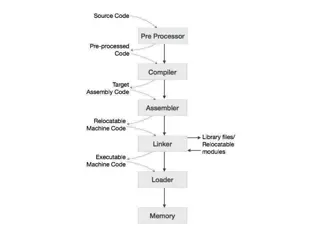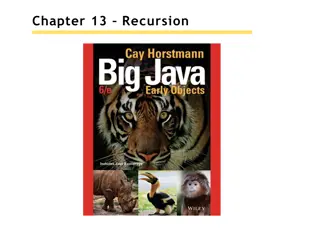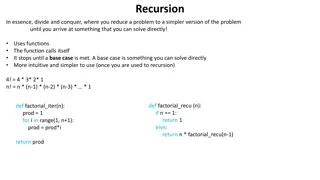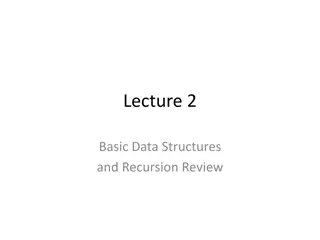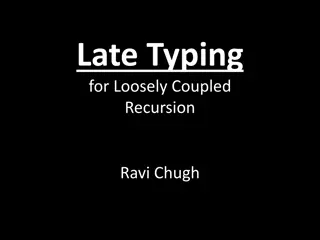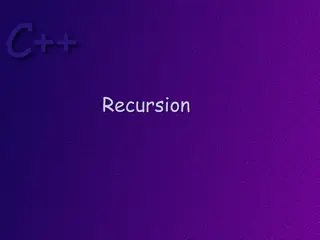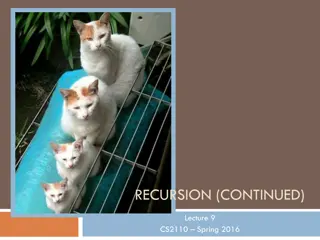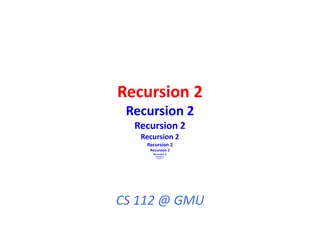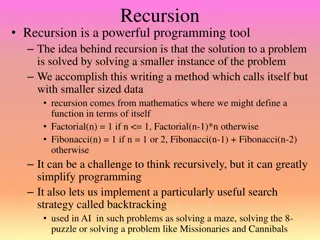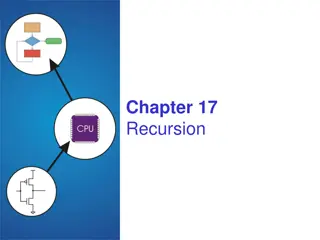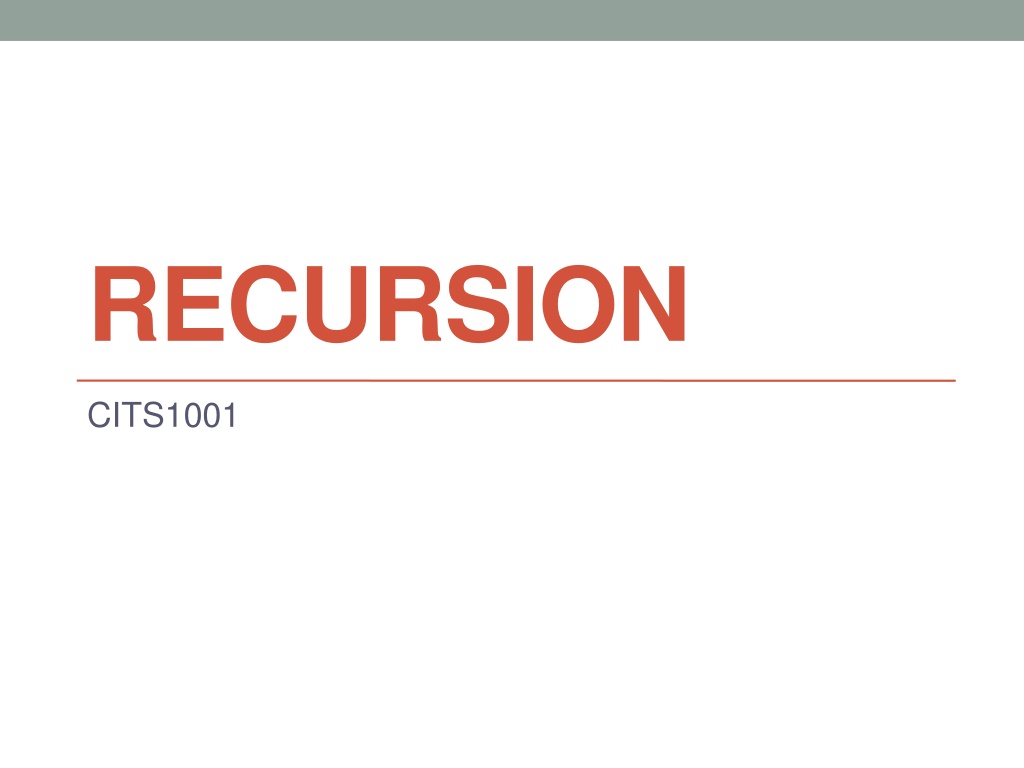
Understanding Recursion in Programming
Explore the concept of recursion in programming, covering simple examples, pitfalls, recursive data, and more. Learn how recursion is a powerful technique for breaking down complex problems and the importance of understanding its computational costs. Enhance your knowledge with examples and resources from Princeton.
Download Presentation

Please find below an Image/Link to download the presentation.
The content on the website is provided AS IS for your information and personal use only. It may not be sold, licensed, or shared on other websites without obtaining consent from the author. If you encounter any issues during the download, it is possible that the publisher has removed the file from their server.
You are allowed to download the files provided on this website for personal or commercial use, subject to the condition that they are used lawfully. All files are the property of their respective owners.
The content on the website is provided AS IS for your information and personal use only. It may not be sold, licensed, or shared on other websites without obtaining consent from the author.
E N D
Presentation Transcript
RECURSION CITS1001
2 Scope of this lecture Concept of recursion Simple examples of recursion Pitfalls of recursion Recursive data Interesting examples of recursion The text does not have a chapter on recursion We recommend these notes from Princeton: http://introcs.cs.princeton.edu/java/23recursion/ Some examples in these notes are sourced from there
3 Recursion We have already seen that a method can call other methods Either in the same class or in other classes However a method can also call itself This self-referential behaviour is known as recursion Recursion is a powerful technique for expressing certain complex programming tasks It provides a very natural way to decompose some problems There are computational costs and other potential pitfalls associated with recursion The careful programmer will always be aware of these
4 The simplest example The factorial of a positive integer k is the product of the integers between 1 and k k! = 1 2 3 (k 1) k In Java: private long factorial(long k) { long z = 1; for (long i = k; i > 1; i ) z *= i; return z; }
5 Think different! k! = 1 2 3 (k 1) k (k 1)! = 1 2 3 (k 2) (k 1) k! = [1 2 3 (k 1)] k k! = (k 1)! k This is a recursive definition of factorial Factorial defined in terms of itself It uses factorial to define factorial
6 Something else is required 4! = 4 3! = 4 3 2! = 4 3 2 1! = 4 3 2 1 0! = 4 3 2 1 0 ( 1)! We need something to tell it when to stop! The base case of the recursion is when we know the result directly 1! = 1
7 Recursive factorial in Java private long factorial(long k) { if (k == 1) return 1; else return k * factorial(k 1); } In the base case factorial stops and returns a result directly In the recursive case factorial calls itself with a smaller argument
8 How does Java execute this? private long factorial(long k) { if (k == 1) return 1; else return k * factorial(k 1); } 24 factorial(4) = 4 * factorial(3) 6 = 3 * factorial(2) 2 factorial(3) factorial(2) = 2 * factorial(1) 1 factorial(1) = 1
9 Every k is a local variable Each invocation of factorial has its own independent parameter k factorial(4) creates a local variable k = 4 Then factorial(3) creates its own local variable k = 3 Then factorial(2) creates its own local variable k = 2 Then factorial(1) creates its own local variable k = 1 The compiler manages all of these variables for you, behind the scenes Exactly as if you called any other method multiple times Each invocation would have its own local variable(s)
10 Ingredients for a recursive definition Every recursive definition must have two parts One or more base cases Each base case represents some trivial case , where we return a result directly These are essential so that the recursion doesn t go on forever Often either a number being 0 or 1, or an array segment having length 0 or 1, or an empty ArrayList, or One or more recursive cases The result is defined in terms of one or more calls to the same method, but with different parameters The new parameters must be closer to the base case(s) in some sense Often a number getting smaller, or an array segment getting shorter, or two numbers getting closer together, or
11 Multiple base cases Each Fibonacci number is the sum of the previous two Fibonacci numbers F1 = 1 F2 = 2 Fk = Fk 1 + Fk 2, if k 3 1, 2, 3, 5, 8, 13, 21, 34, 55,
12 Fibonacci in Java private long fib(long k) { if (k == 1) return 1; else if (k == 2) return 2; else return fib(k 1) + fib(k 2); } This version is appalling slow, though The number of calls to calculate fib(k) is Fk
13 Faster Fibonacci private long fib1(long k) { return fib2(k, 1, 1); } private long fib2(long k, long x, long y) { if (k == 1) return x; else return fib2(k 1, x + y, x); } The number of calls to calculate fib1(k) is k 1 Make sure you understand that fib1(k) = fib(k)
14 Really fast Fibonacci private long fib3(long k) { double sq5 = Math.sqrt(5); double phi = (1 + sq5) / 2; return Math.round(Math.pow(phi, k + 1) / sq5); } Constant time! Make sure you understand that fib3(k) = fib(k)
15 Binary search Linear search means searching a data structure by inspecting every element in turn This is very slow for large data If the data is sorted, we can use the much faster binary search Assume we are given an array of numbers in ascending order, and we want to check if the number z is in the array Inspect the middle number If z is bigger than the middle number, then ifz is in the array, it must be in the top half All numbers in the bottom half are smaller than z and can be ignored If z is smaller than the middle number, then ifz is in the array, it must be in the bottom half
16 Code for binary search // search a for z public static boolean binarySearch(int[] a, int z) { return bs(a, 0, a.length - 1, z); } // search a[l..u] inclusive for z private static boolean bs(int[] a, int l, int u, int z) { if (l == u) return a[l] == z; else { int m = (l + u) / 2; if (z > a[m]) return bs(a, m + 1, u, z); else return bs(a, l, m, z); } }
17 Binary search in action Searching for 29 3 5 6 11 12 14 17 20 26 28 31 32 35 39 41 Not found!
18 Performance of binary search Binary search is fast because in each recursive call, the size of the array that must be searched is reduced by a factor of two So there will be at most log2n+1 calls, where n is the size of the original array e.g. for an array of size 1,000, only 11 items must be inspected e.g. for an array of size 1,000,000, only 21 items e.g. for an array of size 1,000,000,000, only 31 items The base case is guaranteed to be hit because in each recursive call, the array segment gets smaller u l defines the length of the array segment still to search u l gets smaller in each call When u l hits 0, we use the base case
19 Potential pitfalls of recursion There are several common issues with using recursion Study the following examples to give yourself the best chance of avoiding them! The following methods are supposed to calculate harmonic numbers ? 1? 12+ + ?? = ?=1 11+ 1? 1+ 1? ?? = https://en.wikipedia.org/wiki/Harmonic_number https://en.wikipedia.org/wiki/Harmonic_number
20 No base case(s) This version of harmonic has the recursive case correct private double harmonic(int n) { return harmonic(n-1) + 1.0/n; } However it has no base case It will repeatedly call itself forever This is known colloquially as an infinite loop Eventually it will crash with a stack overflow error
21 No guarantee of convergence This version of harmonic has a correct base case, but the recursive case is incorrect private double harmonic(int n) { if (n == 0) return 0; else return harmonic(n) + 1.0/n; } The recursive argument is not smaller than the original call It will go into an infinite loop for any argument except 0
22 Components in the wrong order This version of harmonic has the right components, but in the wrong order private double harmonic(int n) { return harmonic(n-1) + 1.0/n if (n == 0) return 0; } The test for base case or recursive case must come first
23 Not hitting base case(s) This version of harmonic tries to be clever and do two steps together private double harmonic(int n) { if (n == 0) return 0; else return harmonic(n-2) + 1.0/(n-1) + 1.0/n; } This works for even n, but it fails for odd n Odd n generates recursive calls with odd arguments and so misses 0 And anyway it s more complicated than it needs to be
24 Excessive memory requirements This version of harmonic is correct private double harmonic(int n) { if (n == 0) return 0; else return harmonic(n-1) + 1.0/n; } But if we call it with a very large argument, it may still cause a stack overflow error Each recursive invocation consumes memory inside the system Too much memory consumed and the system fails
25 Excessive recomputation This version of fibonacci from earlier is correct private long fib(long k) { if (k == 1) return 1; else if (k == 2) return 2; else return fib(k-1) + fib(k-2); } But it involves a huge amount of repeated calculation Try tracing it for k = 7 It will fail for any significant value of k Recursion often hides such recomputation
26 Recursive data Consider a class that describes the hierarchical structure of a company Each person is an employee Some employees supervise other employees Who might supervise other employees Who might supervise other employees This has a natural recursive structure How do we represent this in Java?
27 Employee data includes Employee public class Employee { private int IDnumber; private Employee supervisor; private Employee[] staff; } Every person in the company is an employee Every person has a supervisor(?) Every person has zero or more underlings that they manage directly Each of those underlings is an employee, with a supervisor and underlings
28 An organisational chart Alf Betty Charles Diane Ethel Fred George Hilary Imogen Jack Keith Lucy Mark Nora
29 Employee objects Every person in the company is represented by an Employee object supervisor = null supervisor = Alf supervisor = Lucy staff[0] = Betty staff[1] = Charles staff[2] = Diane staff[0] = Ethel staff[1] = Fred staff = null Alf Betty Mark
30 Employee ranks Every person in the company has a title, which reflects their standing relative to other people in the company public String title() { if (supervisor == null) return President ; else return Vice- + supervisor.title(); } Notice that the recursive call is to a different object
31 Cascading method calls Alf.title() returns President returns Betty.title() Vice- + Alf.title() which is Vice-President returns Mark.title() Vice- +Lucy.title() which is Vice- + Vice- +Hilary.title() which is Vice- + Vice- + Vice- +Diane.title() which is Vice- + Vice- + Vice- + Vice- +Alf.title() which is Vice-Vice-Vice-Vice-President
32 Pass the buck In this situation, most method calls are achieved by simply passing the buck i.e. asking another object to perform some calculation Consider the problem of Alf trying to find out how many subordinates he has Staff, staff-of-staff, staff-of-staff-of-staff, etc. The pass the buck method is to Ask Betty how many subordinates she has Ask Charles how many subordinates he has Ask Diane how many subordinates she has Add those numbers together, and add three (for Betty, Charles, and Diane themselves)
33 The buck stops here All recursion needs a base case, which stops the recursion and returns a result directly In this case, it ll stop at the bottom of the organisation Someone with no underlings can just return 0 E.g. Ethel, Jack, Keith, etc.
34 In Java public int subordinateCount() { if (staff == null) return 0; int num = 0; for (Employee e : staff) num += 1 + e.subordinateCount(); return num; } Again, the recursive call is to a different object
35 Method structure follows data structure In both of these methods, the structure of the data dictates the structure of the code subordinateCount recurses down the hierarchy Every path going down contributes to the result title recurses up the hierarchy The single path back to the root (Alf!) builds the result Many, many algorithms traverse trees of data in this way This data structure implies code structure pattern is much like how a 1D array implies the use of for loops and foreach loops
36 Recursive graphics Simple recursive drawing schemes can lead to pictures that are remarkably intricate e.g. an H-tree of order nand size s is defined as follows: For n = 0, draw nothing For n = 1, draw an H of size s For n > 1, draw an H of size s plus four H-trees of order n 1 and size s/2, each one connected to a tip of the big H
37 Drawing an H-tree // draw an H-tree of order n and size s centred at x,y public void draw(int n, int x, int y, int s) { if (n == 0) return; drawH(x, y, s); // draw the big H // compute the centres of the four half-size H-trees int x0 = x - s / 2; int x1 = x + s / 2; int y0 = y - s / 2; int y1 = y + s / 2; // recursively draw four half-size H-trees of order n-1 draw(n-1, x0, y0, s / 2); // lower left H-tree draw(n-1, x0, y1, s / 2); // upper left H-tree draw(n-1, x1, y0, s / 2); // lower right H-tree draw(n-1, x1, y1, s / 2); // upper right H-tree }
38 Drawing an H // draw an H of size s centred at x,y public void drawH(int x, int y, int s) { // compute the coordinates of the four tips of the H int x0 = x - s / 2; int x1 = x + s / 2; int y0 = y - s / 2; int y1 = y + s / 2; // draw the three line segments of the H sc.drawLine(x0, y0, x0, y1); // left vertical segment sc.drawLine(x1, y0, x1, y1); // right vertical segment sc.drawLine(x0, y, x1, y); // horizontal segment }
39 Recursive graphics An H-tree is a simple example of a fractal A fractal is a geometric shape where (some of) the components are reduced copies of the original Challenge exercise: write a class that takes an argument n and draws recursive trees as shown below Other challenges are available in the Princeton notes
40 A challenging example - counting combinations Another common use of recursion is in enumerating combinations of possibilities Consider partitioning a positive integer n into a sum of smaller positive integers For example 4 could be partitioned in five ways 1 + 1 + 1 + 1 1 + 1 + 2 1 + 3 2 + 2 4 How many distinct ways can we do this for n? http://en.wikipedia.org/wiki/Partition_%28number_theory%29
41 Partitions of n Ultimately we want a method with the following signature that prints out all possible partitions of n // list all ways of partitioning n into numbers public static void listPartitions(int n)
42 Partitions of n into two numbers Let s start with a method that lists all partitions of n into exactly two numbers, e.g. for 7 1 + 6 2 + 5 3 + 4 We only want partitions where the numbers are in ascending order, otherwise we will generate duplicates // list all ways of partitioning n into two numbers public static void listParts2(int n) { for (int i = 1; i <= n / 2; i++) System.out.println(i + " + " + (n - i)); }
43 Partitions of n into three numbers Now consider partitions of n into exactly three numbers, e.g. for 7 1 + 1 + 5 1 + 2 + 4 1 + 3 + 3 2 + 2 + 3 // list all ways of partitioning n into three numbers public static void listParts3(int n) { for (int i = 1; i <= n / 3; i++) for (int j = i; j <= (n - i) / 2; j++) System.out.println(i + " + " + j + " + " + (n-i-j)); }
44 Partitions of n into k numbers For partitions of size two, we need one loop For partitions of size three, we need two nested loops For partitions of size four, we would need three nested loops It gets ugly quickly! And anyway, we need a general method
45 Partitions of n into k numbers Recursion provides an elegant solution The key observation is very simple If p1 + p2+ + pk = n (i.e. p1 + p2+ + pk is a partition of n) Then p2+ + pk = n p1 (i.e. p2+ + pk is a partition of n p1)
46 Partitioning recursively For example, consider the three partitions of 4 that start with 1 1 + 1 + 1 + 1 1 + 1 + 2 1 + 3 This simple observation is the foundation of a recursive algorithm To partition n: Set p1 = 1 and find all partitions of n 1 Set p1 = 2 and find all partitions of n 2 (with smallest number 2) Set p1 = 3 and find all partitions of n 3 (with smallest number 3) Etc. These are the partitions of 3
47 Partitioning recursively in Java // list all ways of partitioning n into numbers, given num numbers on ns private static void listParts(int[] ns, int num, int n) { if (n == 0) { for (int i = 0; i < num - 1; i++) System.out.print(ns[i] + " + "); System.out.println(ns[num - 1]); } else { int min = num == 0 ? 1 : ns[num - 1]; for (int p = min; p <= n; p++) { ns[num] = p; listParts(ns, num + 1, n - p); } } }
48 Code dissection // list all ways of partitioning n into numbers, given num numbers on ns private static void listParts(int[] ns, int num, int n) { if (n == 0) { for (int i = 0; i < num - 1; i++) System.out.print(ns[i] + " + "); System.out.println(ns[num - 1]); } else { int min = num == 0 ? 1 : ns[num - 1]; for (int p = min; p <= n; p++) { ns[num] = p; listParts(ns, num + 1, n - p); } } } The remaining number The number of parts assigned so far Parts assigned so far
49 Code dissection // list all ways of partitioning n into numbers, given num numbers on ns private static void listParts(int[] ns, int num, int n) { if (n == 0) { for (int i = 0; i < num - 1; i++) System.out.print(ns[i] + " + "); System.out.println(ns[num - 1]); } else { int min = num == 0 ? 1 : ns[num - 1]; for (int p = min; p <= n; p++) { ns[num] = p; listParts(ns, num + 1, n - p); } } } The base case prints out a complete partition
50 Code dissection // list all ways of partitioning n into numbers, given num numbers on ns private static void listParts(int[] ns, int num, int n) { if (n == 0) { for (int i = 0; i < num - 1; i++) System.out.print(ns[i] + " + "); System.out.println(ns[num - 1]); } else { int min = num == 0 ? 1 : ns[num - 1]; for (int p = min; p <= n; p++) { ns[num] = p; listParts(ns, num + 1, n - p); } } } The recursive case first determines the smallest usable number



